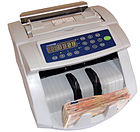- Banknote counter
-
A banknote counter (or bill counter) is a device designed primarily to accurately count a quantity of banknotes. Additionally, a banknote counter may sort banknotes into batches and check for damaged or counterfeit notes.
Contents
History
The first automatic bill counting machines (or banknote counting machines) were introduced in the 1920s in the United States and were produced by the Federal Bill Counter Company of Washington, D.C.. These machines were designed to increase efficiency in tellers in the Federal Reserve Bank and reduce human error. The machine would stop once a set “batch” of notes was reached allowing a teller to insert a wooden block to keep batches separate.[1]
Modern banknote counting machines use a technology developed by Tokyo Calculating Machine Works of Shinagawa, Tokyo and introduced in 1962. It quickly dominated the market for increased speed and accuracy.[2]
In 1981 computerized friction note counters were introduced in the form of the REI High-Speed machine, which sped up note counting to 72,000 notes per hour and eliminated the need manual sorting and counting completely. This innovative machine could also sort notes according to their value and remove counterfeit or heavily damaged notes.[3] Many of these features are present in today’s note counting machines, some of which can detect a note's security features (e.g. magnetic ink, ultraviolet ink, magnetic strip, note density etc.) to identify counterfeit and damaged notes.[4]
Other extra features that facilitate everyday contact with cash may also be present. For example, additions functions, batch functions and format recognition.
Weight based counting
Weight based counting systems exist that can count both notes and coins on the same machine but are normally used to count smaller volumes of notes and do not sort or check for counterfeit or damaged notes.
Weight based money counters do not examine each note or coin separately but work by using finely calibrated loadcells to weigh a number of notes or coins and using a stored weight to perform a calculation to determine the quantity of pieces it has been presented with. These machines often use complex equations to take into consideration the natural variation between individual notes or coins.
Weight based money counters tend to be small in size so are often used on the desktops of bank tellers to check customer deposits or withdrawals or by retailers to count money on the shop floor. Although the capability of weight based money counting machines varies by model, typically they can count both notes and coins and check standard bank bundles or bags/rolls of coin to ensure that they are correct.
Counterfeit detection
Many bill / money counters have counterfeit detection measures built in. The most common are Ultraviolet (UV) and Magnetic (MG) detection. This means the counter will scan the ultraviolet properties of the bill and the magnetic ink in the bill at the same time it is counting the currency. Most bill counters will stop and alert the user when a counterfeit banknote is detected. [5]
Footnotes
- ^ Wells, Donald (2004) The Federal Reserve System: A History (Chapter 6) New York: Digital Vision
- ^ Tavlas, George S. and Yuzuru Ozeki (1992) The Internationalization of Currencies: An Appraisal of the Japanese Yen (Occasional Paper (Intl Monetary Fund)) Washington: International Monetary Fund
- ^ http://www.phil.frb.org/education/counting.html
- ^ http://www.google.com/patents?id=ROoJAAAAEBAJ
- ^ "Bill Counter Guide & Counterfeit Detection". http://www.officezone.com/money-handling-guide.htm. Retrieved 2009-09-10.
External links
Categories:- Banknotes
- Counting instruments
Wikimedia Foundation. 2010.

